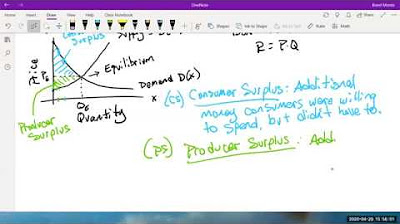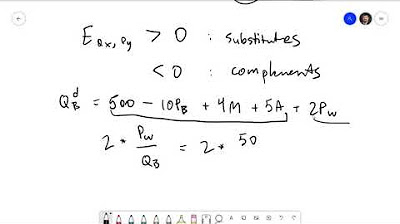Supply and demand in 8 minutes
TLDRIn this educational video, Jacob Clifford aims to simplify the concept of supply and demand for economics students. He explains the inverse relationship of price and quantity demanded, the factors influencing demand shifts, and the positive relationship between price and quantity supplied. Clifford outlines the determinants affecting both demand and supply, illustrating how changes in these factors lead to new equilibrium prices and quantities in the market. The video is designed to be a quick guide, encouraging viewers to practice applying these concepts rather than relying solely on passive viewing.
Takeaways
- 📉 The demand curve shows an inverse relationship between price and the quantity demanded; as price goes up, quantity demanded goes down, and vice versa.
- 🔄 There are three reasons for the law of demand: substitution effect, income effect, and diminishing marginal utility.
- 🍦 Substitution effect: When the price of ice cream rises, people buy alternatives like candy bars; when it falls, they buy more ice cream.
- 💵 Income effect: Higher ice cream prices reduce purchasing power, leading to less ice cream bought; lower prices increase purchasing power and ice cream consumption.
- 📉 Diminishing marginal utility: The more ice cream consumed, the less additional satisfaction is gained, requiring lower prices to encourage more purchases.
- ↔️ Demand shifters include changes in tastes, number of consumers, prices of substitutes and complements, income, and expectations.
- 📈 The supply curve shows a positive relationship between price and quantity supplied; higher prices lead to increased production, and lower prices lead to decreased production.
- 🔄 Supply shifters include changes in resource prices, technology, government actions, number of sellers, and producer expectations.
- ⚖️ Market equilibrium occurs where the quantity demanded equals the quantity supplied, determining the market-clearing price.
- 🔄 Changes in supply or demand can lead to shifts in the equilibrium price and quantity, affecting market outcomes.
Q & A
What is the primary purpose of the video by Jacob Clifford?
-The primary purpose of the video is to save time for economics students by explaining the concepts of supply and demand and bridging the gap between introduction and application as quickly as possible.
What is the inverse relationship between price and quantity demanded as depicted by the demand curve?
-The inverse relationship between price and quantity demanded is that when the price of a product increases, the quantity that consumers are willing and able to buy decreases, and vice versa.
What are the three reasons for a change in demand?
-The three reasons for a change in demand are the substitution effect, the income effect, and the law of diminishing marginal utility.
How does the substitution effect influence demand for a product like ice cream?
-The substitution effect influences demand by causing consumers to switch to other products like candy bars when the price of ice cream goes up, and to switch back to ice cream when its price falls.
What is the income effect and how does it affect the quantity demanded of a product?
-The income effect refers to the change in quantity demanded of a product due to a change in consumers' purchasing power. When the price of a product increases, consumers buy less due to reduced purchasing power, and when the price decreases, consumers can afford to buy more.
What are the five determinants or shifters of demand?
-The five determinants of demand are taste and preferences, number of consumers, price of substitutes and complements, income, and changes in expectations.
Can you explain the positive relationship between price and quantity supplied as shown by the supply curve?
-The positive relationship between price and quantity supplied indicates that when the price of a product increases, producers are willing to supply more in order to make more profit, and when the price decreases, they supply less.
What are the five shifters of supply and how do they affect the supply curve?
-The five shifters of supply are the price of resources or inputs, changes in technology, government actions such as subsidies or taxes, the number of sellers, and changes in expectations. These factors can cause the supply curve to shift to the right (increase) or to the left (decrease).
What is equilibrium in the context of supply and demand?
-Equilibrium is the market condition where the quantity demanded equals the quantity supplied at a certain price, which is referred to as the market clearing price.
What happens to the price and quantity of a product when demand increases?
-When demand increases, the demand curve shifts to the right, leading to an increase in both price and quantity of the product at the new equilibrium.
How does a change in production technology affect the supply of a product like ice cream?
-A change in production technology that allows for faster and cheaper production of ice cream would cause the supply curve to shift to the right, resulting in a decrease in price and an increase in quantity at the new equilibrium.
What is the significance of understanding equilibrium in the context of supply and demand?
-Understanding equilibrium is significant because it helps predict how changes in demand or supply will affect the market price and quantity, which is fundamental to economic analysis and decision-making.
Outlines
📚 Introduction to Supply and Demand
This paragraph introduces the video's purpose, which is to help economics students understand the concepts of supply and demand quickly. Jacob Clifford emphasizes the importance of grasping the fundamental concepts before taking notes. He explains the demand curve, illustrating the inverse relationship between price and quantity demanded, and outlines the three reasons behind the law of demand: the substitution effect, income effect, and the law of diminishing marginal utility. The paragraph also discusses the five determinants of demand that can cause the demand curve to shift, including taste and preferences, number of consumers, price of substitutes and complements, income, and changes in expectations.
📈 Shifts in Demand and Supply
This paragraph delves into the factors that cause shifts in the supply curve, presenting five determinants similar to those affecting demand. These include changes in the price of resources, technological advancements, government actions like subsidies or taxes, the number of sellers in the market, and producers' expectations about future prices. The paragraph clarifies that price changes move along the curve, not shift it, and contrasts this with the shifters that cause the curve to move. The discussion then transitions into how supply and demand interact, leading to market equilibrium, which is defined as the point where quantity demanded equals quantity supplied. Disequilibrium occurs when price changes lead to a surplus or shortage. The paragraph concludes by emphasizing the importance of practice in understanding the dynamics of shifting demand and supply.
Mindmap
Keywords
💡Demand
💡Supply
💡Equilibrium
💡Substitution Effect
💡Income Effect
💡Law of Diminishing Marginal Utility
💡Shifters of Demand
💡Shifters of Supply
💡Market Clearing Price
💡Price Controls
Highlights
Introduction to the video's purpose: to quickly bridge the gap between the introduction and application of supply and demand concepts in economics.
Advice to not take notes during the first viewing, focusing on understanding the concepts before revisiting for note-taking.
Explanation of the demand curve and the inverse relationship between price and quantity demanded.
Three reasons for the law of demand: substitution effect, income effect, and law of diminishing marginal utility.
Illustration of how price changes move along the demand curve, while other factors cause the curve to shift.
Identification of five determinants of demand that cause the demand curve to shift: taste and preferences, number of consumers, price of substitutes and complements, income, and change in expectations.
Clarification that price is not a shifter of demand; it only moves along the curve.
Introduction to the supply curve and its positive relationship with price and quantity supplied.
Reasoning behind the supply curve's movement: the impact of profit on production levels.
Listing of five shifters of supply: price of resources, technology, government action, number of sellers, and change in expectations.
Emphasis on the distinction that price does not shift the supply curve; it only moves along it.
Combining supply and demand to find equilibrium, the market clearing price where quantity demanded equals quantity supplied.
Description of disequilibrium scenarios, such as shortages and surpluses, and how they lead to a return to equilibrium.
Application of supply and demand equilibrium to predict changes in price and quantity due to various factors.
Examples of how changes in demand or supply, such as a study on ice cream's effects or a change in production technology, impact price and quantity.
Encouragement to practice different scenarios of shifting demand and supply for better understanding.
Acknowledgment of additional concepts not covered in the video, such as price controls and elasticity, and the importance of further learning and practice.
Transcripts
Browse More Related Video
5.0 / 5 (0 votes)
Thanks for rating:





